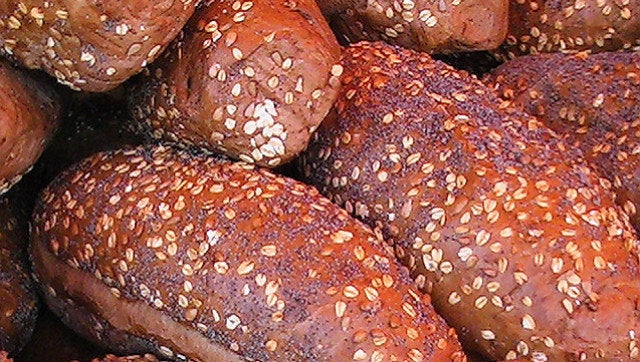
White bread is out, whole grains are in, and "whole grain" is one of the hottest-selling health claims. The USDA's 2010 dietary guidelines recommend that at least half of daily grains be whole, and school lunch programs are required to serve half of the grains offered during the school week as whole ones.
Why Whole Grain?
Whole-grain foods have a higher content of micronutrients, polyphenols, "good" fats and fiber. They also have a lower glycemic index. Whole-grain food consumption is associated lower risk of heart disease, weight gain and diabetes. Whole grains are also preferred for what they're not: refined grains have lots of pure carbs -- plain sugars, which supply energy, but little else.
But how do we define a whole-grain food?
You'd be surprised to learn that there's very little standardization of the whole-grain declaration. In the U.S., a food product can use the official "whole grain" health claim if it contains at least 51 percent whole-grain ingredients by weight. But not all genuine whole-grain foods carry the official claim, and a food can qualify for the whole-grain claim despite containing lots of added sugar and trans fat -- so whole-grain junk food certainly exists. Foods can boast "made with" and "contains" whole grains without any specifics about the percentage of such grains.
So when you're standing next to the cereal aisle, what do you look for? The Whole Grain Stamp on the front of the package? Whole-grain flour as the first ingredient? Did you bring your glasses and a calculator?
Navigating Whole Grains
A new study from the Harvard School of Public Health in Public Health Nutrition identified 545 grain products from the virtual shelves of Wal-Mart and Stop & Shop, looked at them through five different whole-grain criteria, and evaluated which criterion best measures the healthfulness of the product.
The five ways whole grains were assessed were:
- The Whole Grain Stamp: The icon created by the Whole Grains Council can be displayed if the products have at least 8 g of whole grain per serving. Companies pay $1,000 to $9,000 in annual dues be part of this program.
Useful criteria would be practical, identify foods that are healthier, and find enough of them to give customers (and schools) plenty of options to choose from.
The best guideline according to the authors, led by Rebecca Mozaffarian, was the 10:1 ratio. This method asks for a little bit of work: Divide the total carbs by the total fiber on the nutrition label. For instance, one serving of Cheerios has 22 grams of carbs and three grams of fiber, and without doing the exact calculation, it's clear that the ratio is less than 10:1 (it's about 7:1), which puts this cereal in the satisfactory list. The 10:1 identifies foods with more fiber and less sugar. (The neat point about this method is that if there were lots of added sugar it would add to the total carbs, changing the score for the worse).
One obvious loophole in this approach is that manufacturers can easily add bran to the product, upping the fiber content, and reaching a ratio that's closer to 10:1. (Sugar water with vitamins isn't the same as fruit, and refined grain products with added fiber just aren't whole grain -- our body does know the difference.)
The industry-supported Whole Grain Stamp helped identify products with more fiber, but many of them also had more sugar, and a higher caloric count, and many whole-grain products don't carry the stamp.
Whole grain as the first ingredient, which I think is quite popular among health-conscious consumers, and "whole-anywhere," were much less restrictive, and qualified more products, but they, too, failed to weed out foods with more sugar and more calories.
Whole grain as first ingredient and no added sugars was quite restrictive, and qualified only 17 percent of the tested products. Another downside is that this method requires a very careful read of the ingredient list -- added sugars hide under many guises such as brown rice syrup and fruit juice concentrate, and our food label doesn't give us any idea about how much sugar was added.
The Take-Home Message
This article will definitely make me look further into the 10:1 ratio, which, frankly, I'd never thought of before. And it definitely sheds new light on the industry-supported Whole Grain Stamp. The symbol signifies the presence of significant amounts of whole grains, but consumers should know it looks at no other ingredients and factors affecting healthfulness.
No matter which guideline -- or combination of guidelines -- you use, you need to read the ingredient list because, as this study reemphasizes, the words "whole grain" don't necessarily
mean this food's wholesome; and in case you're using the 10:1 ratio, make sure the product didn't get there by adding fiber. Clearly, consumers could benefit from a clever food label makeover that can better assist them in whole-grain product selection.
One of the best ways to eat whole grains is to make them yourself, and while I'm not suggesting you start baking your daily loaf from wheat you grew in your backyard, cooking brown rice, oatmeal (oatmeal is always whole grain), quinoa and wheat berries is practical, inexpensive and 100 percent whole grain!
Dr. Ayala
For more by Ayala Laufer-Cahana, M.D., click here.
For more on diet and nutrition, click here.